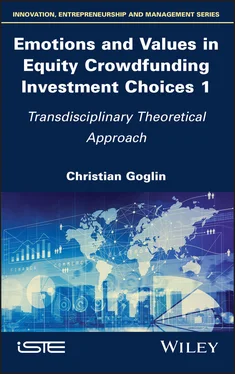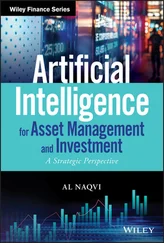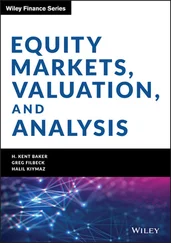Christian Goglin - Emotions and Values in Equity Crowdfunding Investment Choices 1
Здесь есть возможность читать онлайн «Christian Goglin - Emotions and Values in Equity Crowdfunding Investment Choices 1» — ознакомительный отрывок электронной книги совершенно бесплатно, а после прочтения отрывка купить полную версию. В некоторых случаях можно слушать аудио, скачать через торрент в формате fb2 и присутствует краткое содержание. Жанр: unrecognised, на английском языке. Описание произведения, (предисловие) а так же отзывы посетителей доступны на портале библиотеки ЛибКат.
- Название:Emotions and Values in Equity Crowdfunding Investment Choices 1
- Автор:
- Жанр:
- Год:неизвестен
- ISBN:нет данных
- Рейтинг книги:3 / 5. Голосов: 1
-
Избранное:Добавить в избранное
- Отзывы:
-
Ваша оценка:
- 60
- 1
- 2
- 3
- 4
- 5
Emotions and Values in Equity Crowdfunding Investment Choices 1: краткое содержание, описание и аннотация
Предлагаем к чтению аннотацию, описание, краткое содержание или предисловие (зависит от того, что написал сам автор книги «Emotions and Values in Equity Crowdfunding Investment Choices 1»). Если вы не нашли необходимую информацию о книге — напишите в комментариях, мы постараемся отыскать её.
Emotions and Values in Equity Crowdfunding Investment Choices 1 — читать онлайн ознакомительный отрывок
Ниже представлен текст книги, разбитый по страницам. Система сохранения места последней прочитанной страницы, позволяет с удобством читать онлайн бесплатно книгу «Emotions and Values in Equity Crowdfunding Investment Choices 1», без необходимости каждый раз заново искать на чём Вы остановились. Поставьте закладку, и сможете в любой момент перейти на страницу, на которой закончили чтение.
Интервал:
Закладка:
Finally, these different explanations for the choice of projects are all based explicitly or implicitly on signal theory, in which the decision-maker is endowed with an instrumental rationality and seeks, by capturing quality signals, to maximize its usefulness, which can be identified by the risk/return ratio for finance. This perspective, which derives from the neoclassical school’s postulates of rationality that prevail within the efficiency of financial markets, reduces choice to its cognitive dimension, which excludes any emotional or affective explanation.
Nevertheless, a body of emerging research converges to admit that the choice of projects may be based on reasons other than an exclusive maximization of the expected utility, and even places emotions at the heart of the phenomenon of ECF investments.
Thus, the choice of ECF projects can be connected to the intrinsic motivations of investors. Ryu and Kim (2014) establish this link and show that if the investor is driven by a motivation such as “philanthropy”, “recognition” or “relationship”, then the reward, i.e. the expected return, has no effect on the choice, contrary to the expected social contribution.
Bessière and Stéphany (2017) believe that crowds act based more on their perceptions than on in-depth analysis; the decision is holistic, intuitive and affect plays an essential role, as does familiarity with risk perception, the latter being altered by the affect heuristic.
In the field of entrepreneurship, several authors examined the effects of entrepreneurial affect (Milovac et al . 2015), pitch (Davis et al . 2017) and narrative emotions (Wuillaume et al . 2016) on investors; their evaluation; and their choices. In addition, Allison et al . (2017) studied the phenomenon of persuasion that is at play between entrepreneurs and investors.
In the field of human–computer interaction, Josue and Bahm (2016) propose a method for measuring the emotional impact of pitch videos on sponsors, in line with the results uncovered in the field of marketing regarding the impact of videos on consumer attitudes (Graillot 1996).
The ECF investment framework presents several characteristics that probably make a marketing approach relevant: intrinsic and extrinsic motivations (Hemer 2011), a consumer rather than shareholder logic, linked to limited information and a lack of financial expertise (Bessière and Stéphany 2014), but, above all, a context of persuasion through storytelling, images and video pitches, which are the ingredients of the phenomenon of advertising persuasion studied in the field of consumer theory.
Moreover, beyond the management sciences, in the social sciences and humanities, more specifically, in the fields of the psychology of emotions and judgment and decision - making, the effects of emotional reactions on judgments and decisions are well-established (Zajonc 1980; Frijda 1986; Loewenstein et al . 2001; Slovic et al . 2002; Kahneman 2003). The neurosciences consolidate the theoretical edifice with the work of Bechara and Damasio (2005) on the somatic marker hypothesis, which constitutes, in a way, the linchpin.
This book falls within the field of behavioral finance, at the crossroads of finance and psychology, but is not confined to these disciplines, because knowledge cannot stop at the clear edge of a definition or disciplinary divides. Thus, an interdisciplinary theoretical framework is used, including concepts, models and theories that are reasonably transferable and capable of improving the understanding of our research object.
Purpose of the research
The purpose of this research is to understand, explain and predict the emotional dimension of project choices by ECF investors, without excluding the cognitive dimension. The particular role of a variable of congruence of the investor’s values with those put forward by the project is highlighted, which explains the title of this book. This variable, which is directly related to affective reactions (Schwartz 2006), emerged in the course of the research by means of abductive inference, and was then confirmed theoretically, but also empirically, because of a substantial body of qualitative data. Therefore, from our point of view, the rationality of the investor is complex, an axiological rationality is added to his instrumental rationality, as well as an “affective rationality” that we will define.
This work is exploratory in nature: its aim is to produce an original theory that brings a different and complementary perspective to signal theory. This theory is called the “affective matching” theory; part of its roots lie in the interactionist theory of “ Fit- IO” for which individuals are attracted to organizations whose values and norms are congruent with their personal values and norms (Chatman 1989; Kristof 1996; Chapman et al . 2005). The theory of “affective matching” is also in line with the theories of “cognitive consistency” (Vaidis and Halimi-Falkowicz 2007), and it requires the investor to match the project with which they have a minimum “affective distance” or, equivalently, a maximum “affective matching”. The term “affective matching” replaces the term “utility” used in economic decision theory, because the model is not exclusively consequentialist, but nevertheless has similarities with the concept of utility taken from the original meaning of the precursors of decision theory, for which it was a measure of pleasure and punishment (Bentham 1789).
Methodology
Our epistemological approach is postpositivist and the chosen methodology is based on a recursive loop between abduction/deduction/induction types of inference using the body of qualitative data already mentioned (David 1999). An explanatory model is proposed; testing its hypotheses requires the organization of a controlled experiment. Its empirical validation is based on a structural equation model. Additonally, a second model that was developed as an extension of the explanatory model and qualified as an individual predictive model implements the theory of affective matching; testing its predictive quality requires developing an original similarity measure like the distance between vectors.
Expected contributions
The issue of this book is first of all theoretical: this research aims to contribute to the emerging movement of ECF research that advocates a project choice based on the affect and not exclusively on the cognitive. The proposed theory of affective matching and its implementation by an individualized model makes, on the one hand, the prediction of Mangot (2013) – for whom “behavioral finance should not, in the near future, be spared an approach aimed at personalizing behaviors” – a reality and responds, on the other hand, to the call of Pare and Rédis (2011) for the “integration of concepts, and even methods from other disciplinary fields” in order to go beyond the “hypotheses of traditional finance, which are, as has been shown, unsuitable for the new company”.
The theoretical questions to which this book will try to provide some answers are as follows:
– Do values and emotional reactions determine the choice of projects in ECF?
– What are the relative influences of these two variables?
– What is the link between values and affective reactions?
– What is the history of affective reactions?
– In the absence of social interactions, does the affective dimension dominate over the cognitive dimension of choice?
– Can an explanatory and predictive model of individual choice be established a priori based on knowledge of investor preferences?
– Is such a model meant to be normative?
– What is the investor’s rationale?
Читать дальшеИнтервал:
Закладка:
Похожие книги на «Emotions and Values in Equity Crowdfunding Investment Choices 1»
Представляем Вашему вниманию похожие книги на «Emotions and Values in Equity Crowdfunding Investment Choices 1» списком для выбора. Мы отобрали схожую по названию и смыслу литературу в надежде предоставить читателям больше вариантов отыскать новые, интересные, ещё непрочитанные произведения.
Обсуждение, отзывы о книге «Emotions and Values in Equity Crowdfunding Investment Choices 1» и просто собственные мнения читателей. Оставьте ваши комментарии, напишите, что Вы думаете о произведении, его смысле или главных героях. Укажите что конкретно понравилось, а что нет, и почему Вы так считаете.












